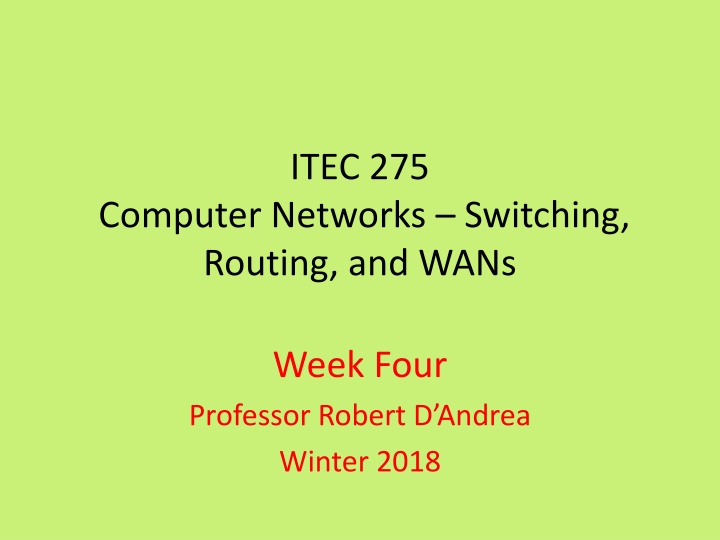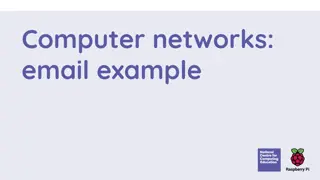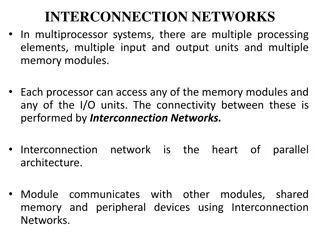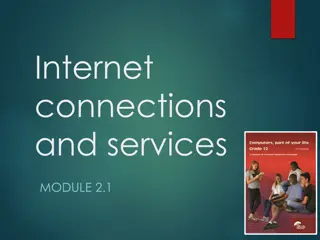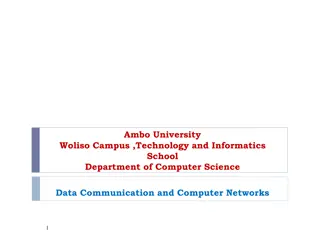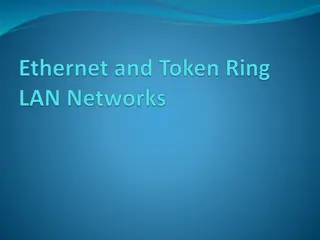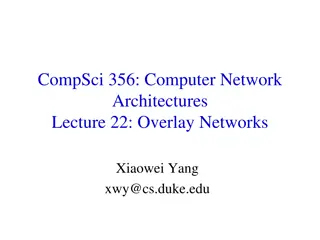Computer Networks and WANs: Week Four Overview
This week's session covers VMware View Client commands, traffic flow device configurations, Asynchronous Transfer Mode (ATM), Quality of Service (QoS), and more. Explore hands-on activities in MIMIC Virtual Lab CCNA and learn essential commands for networking tasks like configuring interfaces, debugging, and managing system information.
Download Presentation

Please find below an Image/Link to download the presentation.
The content on the website is provided AS IS for your information and personal use only. It may not be sold, licensed, or shared on other websites without obtaining consent from the author.If you encounter any issues during the download, it is possible that the publisher has removed the file from their server.
You are allowed to download the files provided on this website for personal or commercial use, subject to the condition that they are used lawfully. All files are the property of their respective owners.
The content on the website is provided AS IS for your information and personal use only. It may not be sold, licensed, or shared on other websites without obtaining consent from the author.
E N D
Presentation Transcript
ITEC 275 Computer Networks Switching, Routing, and WANs Week Four Professor Robert D Andrea Winter 2018
Agenda Learning Activities Logging into the VMware View Client Commands Lite review of week three slides Traffic flow Traffic flow device configurations ATM QoS GoS
Command: ? Exec commands: clear Reset functions clock Configure serial interface clock configure Enter configuration mode connect Open a terminal connection copy Copy from one file to another debug Debugging functions (see also 'undebug') delete Delete a file disable Turn off privileged commands disconnect Disconnect an existing network connection enable Turn on privileged commands erase Erase a filesystem exit Exit from the EXEC help Description of the interactive help system logout Exit from the EXEC no Negate a command or set its defaults ping Send echo messages reload Halt and perform a cold restart show Show running system information systat Display information about terminal lines
Command: Show ? access-lists List access lists aliases Display alias commands arp ARP table backup Backup status buffers Buffer pool statistics cdp CDP information clock Display the system clock compress Show compression statistics configuration Contents of Non-Volatile memory controllers Interface controller status dialer Dialer parameters and statistics flash: display information about flash: file system frame-relay Frame-Relay information history Display the session command history hosts IP domain-name, lookup style, nameservers, and host table interfaces Interface status and configuration ip IP information ipv6 IPv6 information isis IS-IS routing information location Display the system location logging Show the contents of logging buffers modemcap Show Modem Capabilities database privilege Show current privilege level protocols Active network routing protocols running-config Current operating configuration snmp snmp statistics startup-config Contents of startup configuration terminal Display terminal configuration parameters users Display information about terminal lines version System hardware and software status
Command: Configure Configure commands: access-list Add an access list entry alias Create command alias banner Define a login banner cdp Global CDP configuration subcommands class-map Configure QoS Class Map dialer-list Create a dialer list entry enable Modify enable password parameters end Exit from configure mode exit Exit from configure mode frame-relay global frame relay configuration commands help Description of the interactive help system hostname Set system's network name interface Select an interface to configure ip Global IP configuration subcommands ipv6 Global IPv6 configuration subcommands isdn ISDN configuration commands key Key management line Configure a terminal line
Command: Configure Configure commands: logging Modify message logging facilities no Negate a command or set its defaults policy-map Configure QoS Policy Map router Enable a routing process snmp-server Modify SNMP parameters trunk Configure a trunk group username Establish User Name Authentication
WARNING! Every VMware View Client login is a new session Any previous work will be lost unless saved to a local drive Any files uploaded for a project will have to be reloaded
Review Week Three Characterize the infrastructure of the existing network - Develop a set of network maps - Learning the locations of major internetworking devices - Identify all network segments - Identify any standard methods for addressing and naming convention
Review Week Three Document -Types and lengths of actual cable and fiber - Investigate architectural constraints - Investigate environmental constraints - Investigate important aspects of characterizing the network infrastructure.
Week Three Review How to begin characterizing? Top-down method that shows high-level to low-level information. Global WAN WAN to LAN Identify each campus network Buildings, floors, and rooms Location(s) of servers and main-frames Location(s) of routers and switches Location(s) of LANs and VLANs Create a map that displays network services
Review Week Three Characterize the logical architecture - Develop network diagrams of the company - Develop modular block diagrams Characterize the network addressing and naming Characterize wiring and media - Develop wiring within buildings - Verify architecture and environmental constraints - Develop any wireless installations with a wireless site survey
Review Week Three Baseline the existing network Dedicate the right amount of time for the baseline Record the existing networks errors Record the existing networks packet/cell loss Record the existing networks latency issues during normal operating times Record the existing networks performance
Review Week Three Analyze the network availability Analyze the network utilization - Bandwidth used by applications - Bandwidth used by protocols Analyze the network accuracy Analyze the network efficiency Analyze the delays and response times
Week Four Characterize traffic flow - Involves identifying the sources and destinations - Analyzing the direction of traffic - Analyzing the symmetric of traffic
Week Four Identify User Communities and Data Stores A user community is a group of workers who use a particular application. They can exist in a department or group of departments. A User Communities chart should be utilized to record this type of information in. A data store is an area in a network where application layer data resides. A data store can be a number of components; server, server farm, a storage-area network (SAN), main-frame, a tape backup unit, a digital video library, or where large quantities of data are stored.
Week Four Documenting Traffic Flow of the Existing Network Identify and characterize individual traffic flows between traffic source and stores. To understand traffic flow better by reading RFC 2722. Measuring traffic flow behavior Characterize the behavior of existing networks Plan for network development and expansion Quantify network performance Verify the quality of network services Assign network usage to users and applications
Week Four Documenting Traffic Flow of the Existing Network Flow has attributes: Direction Symmetry Routing path and routing options Number of packets Number of bytes Addresses for each end of the flow Characterizing the size of a flow by measuring the number of megabytes per second (MBPS) with a protocol analyzer.
Week Four Traffic Flow Bidirectional and symmetric is when both ends of the flow send traffic at the same rate. Bidirectional and asymmetric is when the client sends small queries and servers send large streams of data. Broadcast flow is unidirectional and asymmetric.
Week Four Typical flows found in major vendor devices are Netgear Cisco 3COM Juniper HP HPE/Aruba SolarWinds Linksys
Week Four Typical flow formats are as follows: Netflow sflow cflow j-flow Appflow Netstream FNF IPFIX
Week Four Netflow Analyzer Capabilities Bandwidth monitoring and traffic analysis Monitor network bandwidth and traffic patterns at an interface level Network forensics and security analysis Detect a broad array of external and internal security threats Application-centric monitoring and shape application traffic Recognize and classify non-standard applications that hog your network bandwidth
Week Four Netflow Analyzer Capabilities Capacity planning and billing Make informed decisions on your bandwidth growth using capacity planning reports Monitor voice, video and data effectively Analyze IP service levels for network-based applications and services Multivendor support and flow technology Collects and reports on different vendor products
Week Four What is Netflow? NetFlow is a network protocol developed by Cisco for collecting IP traffic information and monitoring network traffic. By analyzing flow data, a picture of network traffic flow and volume can be built.
Week Four Cisco NetFlow collects and measures data as it enters a router and switch interface, it s source, and destination , IP address, source and destination TCP or UDP port numbers, packet and byte counts. The objective is to document the megabytes per second between pairs of autonomous systems, networks, hosts, and applications. Use the Network Traffic Flow on the Existing Network form to document this information.
Week Four Cisco NetFlow Packets enter the router interface. If the router has never seen the packet it will make an entry in the Flow Cache table. The Flow Cache table contains the following fields: Destination IP Source IP Destination Port Source Port Source Interface Protocol TCP Bytes
Week Four Router
Week Four Cisco NetFlow The packet information is recorded in the Flow Cache and routed out to the destination interface. As the succeeding packets that match the existing Flow Cache flow through the router, the byte and packet counts keep incrementing for each packet. Destination IP: 1.1.1.1 Source IP:2.2.2.2 Destination Port: 80 Source Port:5555 Source Interface: 1 Protocol TCP: TCP Bytes: 92
Week Four Cisco NetFlow Packets that entered the router that have a different flow entry are first determined to be routable. If so, then they are entered into the Flow Cache. A flow cache can contain hundreds of thousands of entries, and into the millions. When the NetFlow expires, then they are sent to the NetFlow Collector, which will analyze and archive the flows for future reference. Destination IP: 1.1.1.1 Source IP:2.2.2.2 Destination Port: 80 Source Port:5555 Source Interface: 1 Protocol TCP: TCP Bytes: 800 3.3.3.3 3.4.4.4 80 8888 2 TCP 60
Week Four Cisco NetFlow These records are later checked for the following: Threats detected Network topology Graphical trends NetFlow is used to find Bandwidth Monitoring finding the hogs on the system Comprehensive Cyber threats forensics Isolating application slowness Billing based on usage.
Week Four Cisco NetFlow Many hardware vendors are adopting IPFIX, which is the standard for NetFlow the official flow for all technologies. IPFIX and NetFlow can be found in hardware and software Used as real time technologies Used for packet and flow sampling
Week Four Characterize types of Traffic Flow for the New Network Applications Terminal/host traffic flow (Telnet, asymmetric) Client/server traffic flow (Thin client, bidirectional and asymmetric) Peer-to-peer traffic flow (ftp, NFS, and HTTP, bidirectional and symmetric) Server/server traffic flow ( implement directory services, cache heavily used data, and to mirror data, bidirectional and symmetric) Distributed computing traffic flow (task manager, applications that require multiple computing nodes)
Week Four Client/Server Model: There is software on the client and software on the server. The server software sits and waits for the clients to make a request of the server. Envision the server as a robot, go here, get this, and return this. The server performs whatever the client requests and returns it to the client. The server is no special machine, it can be any machine or your machine. It does have some unique characteristics. It has no monitor, configured with a particular architecture to access and retrieve files quickly. Servers normally have large mounts of memory and data storage capabilities. Generally, servers are connected to the Internet 24/7.
Week Four Client Server Model: Client sends a request to the web server. The server retrieves the file Sends the file (HTML) to the client. The client software is a browser (IE, FireFox, Chrome), receives and displays the information.
Week Four Client Server Model
Week Four Client Server Model Corporate Server URL Laptop HTML File Laptop Client
Week Four Client Server Model The servers have ports. These ports act as numbered doorways. Behind each door is a unique software application. The doorway numbers (ports) are as follows: 20 & 21 FTP 22 SSH 23 Telnet 25 SMTP 53 DNS 80 HTTP (used for World Wide Web) 443 HTTPs
Week Four Client Server Model All nodes on a network act as clients. When these systems need to access a resource, they each request the resource(s) from a particular location known as a server. A server provides a specific resource for a network, such as, database, email, printer, Internet,
Week Four Peer-To-Peer Model perform the same tasks. The computers are equal to each other. One computer can
Week Four Peer-To-Peer Model
Week Four Peer-To-Peer Hibyte - ISP Lobyte - ISP Laptop Laptop Node #1 Node #2
Week Four Traffic Flow in Voice over IP Networks Involves two flows 1. Audio (peer-to-peer flow, Real-Time Transport Protocol ) 2. Set up and tear down (client/server flow)
Week Four Document Traffic Flow for New and Existing Network Applications Use the Network Application Traffic Characteristics form to identify traffic flow for new and existing network applications. Characterize Traffic Load Traffic load information can help characterize networks with sufficient capacity for local usage and internetwork flows. Estimating traffic loads is difficult. Try to avoid bottlenecks in your network design.
Week Four Calculate Theoretical Traffic Load The traffic load is the sum of all the data, all network nodes that are ready to send at a particular time, like horses exiting the starting gates at the same time. The goal is to design the network capacity to be more than adequate to handle the traffic load. The number of stations The average time that a station is idle between sending frames. The time required to transmit a message once medium access is gained.
Week Four Document Application Usage Patterns - Identify user communities - Identify the applications users use Refine Estimates of Traffic Load Caused by Applications - Revisit the size of the data objects sent by applications - The overhead caused by protocol layers, and any other load caused by application initialization.
Week Four Traffic Overhead for the Different Protocols Preamble Header Payload System Level Protocols Address Resolution Protocol (ARP) Dynamic Host Configuration Protocol (DHCP) Internet Control Message Protocol (ICMP) Domain Name System (DNS) Multicast DNS (mDNS) NetBIOS name queries ( runs on the session layer of the OSI model) Network Time Protocol (NTP) Simple Service Discovery Protocol (SSDP) Service Location Protocol (SLP) Simple Network Management Protocol (SNMP)
Week Four Broadcast/Multicast Traffic - A broadcast frame goes to all network stations on a LAN. Routers do not forward broadcasts. IPv6: FF:FF:FF:FF:FF:FF (128 characters) - A multicast frame goes to a subset of stations. IPv6: 01:00:0C:CC:CC:CC Cisco routers and switches running Cisco Discovery Protocol (CDP) on a LAN.
